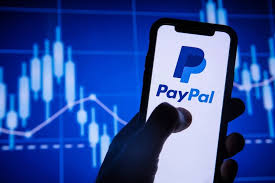Understanding Nasdaq PYPL: Insights, Trends, and Investment Strategies for 2025

As we look toward 2025, understanding Nasdaq PYPL is essential for investors navigating the dynamic world of fintech. PayPal, often recognized by its ticker symbol PYPL, has carved a significant niche in digital payments, revolutionizing the way consumers and businesses transact online. With shifting consumer behaviors and increasing competition, staying informed about emerging trends and strategic insights is crucial for making informed investment decisions.
This article delves into the latest market trends surrounding PYPL, offering a comprehensive analysis of its performance on the Nasdaq and the broader fintech landscape. Whether you’re a seasoned investor or just starting, understanding the nuances of PayPal’s business model and market positioning will equip you with the knowledge needed to capitalize on opportunities in the coming year. Join us as we explore effective investment strategies to help you navigate the complexities of investing in one of the most influential players in the digital payments arena.
Overview of PayPal Holdings, Inc.
PayPal Holdings (NASDAQ: PYPL) is a global leader in digital payments, operating a two-sided platform connecting consumers and merchants across 200+ markets. Founded in 1998 and spun off from eBay in 2015, PayPal revolutionized online transactions with its secure, email-based payment system. Its core offerings include branded checkout solutions, peer-to-peer payments (Venmo), Braintree for merchant processing, and cryptocurrency services. As of Q1 2025, PayPal handles $1.68 trillion in total payment volume (TPV) annually, supported by 4.34 billion active accounts. Despite macroeconomic headwinds, PayPal remains pivotal in the $3.5 trillion global digital payment market.
Historical Performance of Nasdaq PYPL
PayPal’s stock has seen volatility since its 2015 IPO. Shares peaked at $310 in 2021 but plummeted to $68.05 by May 2025 due to slowing revenue growth and rising competition. Key milestones:
2019: Acquired Honey for $4B to enhance shopping tools.
2021: Launched crypto trading and stablecoin PayPal USD.
2023: Venmo processed $256B in P2P payments.
2024: Revenue grew 7% YoY to $31.8B, but EPS declined 24% amid restructuring costs.
Long-term investors have faced challenges, with shares underperforming the S&P 500 since 2022.
Key Financial Metrics to Consider
Revenue: Q1 2025 revenue reached $7.8B, up 1% YoY, driven by transaction fees.
Profitability: Non-GAAP EPS of $1.33 in Q1 2025 beat estimates, but GAAP net income fell 2%.
Margins: Transaction margin rose 7% to $3.7B, reflecting cost optimization.
Valuation: P/E of 15.29 and P/B of 3.27 suggest undervaluation vs. Visa (P/E 27.5)。
Cash Flow: $11.6B operating cash flow supports $6B share buybacks in 2025.
Current Market Trends Affecting Nasdaq PYPL
1. Declining Branded Checkout: PayPal’s market share in branded checkout dropped to 35% as Apple Pay and Google Pay gain traction.
2. BNPL Growth: PayPal Credit and “Pay in 4” now command 18% of the U.S. buy-now-pay-later market.
3. Cryptocurrency Adoption: PayPal USD stablecoin adoption grew 40% QoQ, but regulatory scrutiny persists.
4. Cross-Border Pressures: U.S.-China trade tensions and EU data laws increased compliance costs by 12%.
Analyzing PYPL’s Competitive Landscape
PayPal faces fierce competition:
Block (SQ): Dominates SME payments with Square, but lacks PayPal’s global reach.
Stripe: Leads in developer-friendly APIs but relies on PayPal for 30% of its backend processing.
X (Twitter): Partnered with Visa to launch P2P payments, threatening Venmo’s social payment dominance.
PayPal’s edge lies in its diversified revenue streams, including interest from $37.6B in customer balances.
Investment Strategies for Nasdaq PYPL in 2025
Short-Term Trading: Target volatility around earnings (next report: July 29, 2025)。 Use stop-loss orders below $65.
Long-Term Holding: Accumulate shares below $70, targeting 2027 EPS of $6.50.
Dividend Avoidance: PayPal suspended dividends to prioritize buybacks and debt reduction.
Sector Hedge: Pair PYPL with short positions on overvalued fintech peers like Block.
Risks and Challenges Facing PYPL Investors
1. Margin Erosion: PSP (Braintree) revenue growth slowed to 2% YoY, dragging monetization rates to 1.73%.
2. Regulatory Risks: FTC investigations into PayPal USD and EU antitrust fines could cost $1.5B.
3. Leadership Uncertainty: CEO Alex Chriss’ turnaround plan faces skepticism after Q1 guidance cuts.
4. Debt Burden: $61B total liabilities strain liquidity amid rising interest rates.
Expert Opinions and Predictions for PYPL
Analysts remain divided:
Bulls: Mizuho cites undervalued Venmo and crypto assets, projecting $121 (+36% upside)。
Bears: Morgan Stanley warns of “structural declines” in branded checkout, targeting $88.
Neutral: RBC Capital advises waiting for Q2 TPV growth data before entering.
Consensus 2025 EPS is $4.95–$5.10, implying 10% YoY growth if restructuring succeeds.
Conclusion and Final Thoughts on Investing in PYPL
PayPal offers a high-risk, high-reward proposition. Its entrenched position in cross-border payments and Venmo’s social payment leadership provide long-term tailwinds. However, near-term headwinds—slowing PSP growth, X’s payment ambitions, and regulatory overhangs—demand caution. For investors with a 3–5 year horizon, accumulating shares below $70 could capitalize on its $121 fair value potential. Monitor Q2 2025 earnings (July 29) for signs of margin stabilization and Venmo monetization progress.